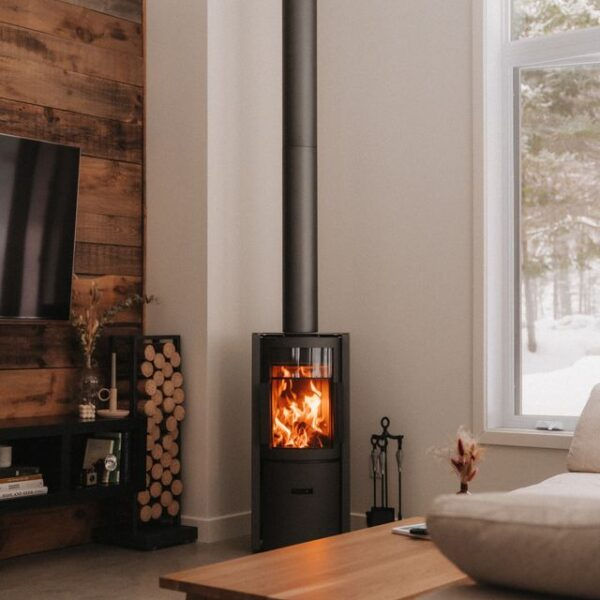Choosing the Right Wood Burning Stove for Your Home
- Southwest Woodburners

- May 18
- 4 min read
Are you considering a wood burning stove for your home? These appliances offer a warm and cozy atmosphere while also providing efficient heating. In this guide, we’ll help you navigate the decision-making process of selecting the ideal wood burning stove for your space.
Understanding Wood Burning Stoves
Wood burning stoves are not only decorative pieces but also practical heating solutions. They burn wood logs to generate heat, which can significantly lower your heating bills during the colder months. There are many types of wood burning stoves available, and the choice largely depends on your home’s design, your heating needs, and your personal preferences.
For instance, a traditional cast-iron stove can add a rustic charm, while a modern, sleek design might suit contemporary homes better. When selecting a wood burning stove, consider factors such as efficiency ratings, safety features, and aesthetics.

Types of Wood Burning Stoves
When choosing a wood burning stove, it's important to know the different types available on the market.
Freestanding Stoves
Freestanding stoves are versatile and can be placed anywhere in your home. They come in various styles and sizes, making it easier to find one that fits your space. Brands like Morso and Jotul offer high-efficiency models that can heat large areas effectively.
Insert Stoves
Insert stoves are designed to fit into an existing fireplace. They provide an upgraded, efficient heating solution without needing extensive renovations. This type of stove can transform a dated fireplace into a modern heating source, adding value to your home.
Pellet Stoves
Pellet stoves utilize compressed wood pellets for fuel. They are very efficient and often come with programmable thermostats, providing convenient heating options. While these stoves offer less traditional charm, they're easier to manage and can be more environmentally friendly.

Are Wood Burning Stoves Being Phased Out?
With increasing concerns about air quality and environmental impacts, many people wonder if wood burning stoves are being phased out. While some stringent regulations have been implemented, particularly in urban areas, wood burning stoves are not disappearing.
Several manufacturers are developing models that comply with stricter emissions standards. These high-efficiency stoves can produce less smoke and fewer pollutants, allowing you to enjoy the beauty of wood burning while minimizing environmental impact.
As regulations evolve, it is crucial to stay informed about local laws and standards regarding wood burning appliances. Engaging with a reputable supplier like southwest woodburners dorset can help you find stoves that meet these regulations and suit your needs.
Benefits of Installing a Wood Burning Stove
There are many reasons to install a wood burning stove in your home. Here we explore some key benefits that make them an attractive option.
Efficient Heating
Wood burning stoves are known for their high efficiency. Most modern models boast an efficiency rating of over 70%. That means a significant portion of the wood you burn translates into heat. This efficiency can lead to lower heating bills and a smaller environmental footprint compared to fossil fuels.
Aesthetic Appeal
Beyond functionality, wood burning stoves also add aesthetic value to your home. They serve as a beautiful focal point in any room. Many styles are available, from classic to contemporary, allowing you to choose a stove that complements your home's design.
Independence from the Grid
In an age where energy prices are continually rising, a wood burning stove allows for independence from utility companies. You can depend on locally sourced wood for fuel, which often proves to be more economical than electric or gas heating.

Things to Consider When Choosing a Wood Burning Stove
Selecting the right wood burning stove requires attention to several factors. Here are key considerations to help you make the best choice.
Size and Heat Output
The stove's size must match the space you want to heat. If you're heating a large open area, opt for a more powerful stove. Many stoves have a BTU (British Thermal Unit) rating indicating their heat output; a higher BTU is necessary for larger spaces.
Fuel Source
Different stoves burn different types of fuel. Some models might only accept seasoned logs, while others can burn pellets or coal. It's essential to decide on the fuel source that works best for you and your location.
Installation and Ventilation
Proper installation is crucial for the safety and efficiency of your wood burning stove. Make sure to consult with professionals who can ensure that your stove meets local codes and regulations. Additionally, adequate ventilation is vital for optimal performance and indoor air quality.
Price and Maintenance
Wood burning stoves can range significantly in price. Set a budget that includes both initial costs and ongoing maintenance. Remember that higher-quality stoves generally require less maintenance and are more efficient over time.
Final Thoughts
Investing in a wood burning stove can enhance your home’s comfort and aesthetics while reducing energy costs. By considering the various types of stoves, their benefits, and important factors such as size and installation, you can make an informed decision.
If you're looking for a specific model or assistance in your search, it's beneficial to consult experts such as southwest woodburners dorset. They can guide you in finding a high-quality wood burning stove that fits your needs and complies with regulations.
Ultimately, taking the time to research and choose the right wood burning stove will lead not only to warmth and comfort in your home but also to an enhanced living experience.
.png)



.png)
Comments